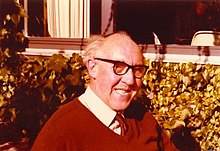| Thomas Willmore | |
|---|---|
 Willmore in 1979 at the Mathematical Research Institute of Oberwolfach, photo by Prof. Konrad Jacobs. Willmore in 1979 at the Mathematical Research Institute of Oberwolfach, photo by Prof. Konrad Jacobs. | |
| Born | (1919-04-16)16 April 1919 Gillingham, Dorset, England |
| Died | 20 February 2005(2005-02-20) (aged 85) |
| Alma mater | King's College London |
| Known for | Willmore energy, Willmore flow, Willmore conjecture |
| Scientific career | |
| Fields | Mathematician |
| Institutions | King's College London, University of Durham, University of Liverpool |
| Notes | |
| Note: PhD written/gained during WWII, advisor unknown | |
Thomas James Willmore (16 April 1919 – 20 February 2005) was an English geometrist. He is best known for his work on Riemannian 3-space and harmonic spaces.
Willmore studied at King's College London. After his graduation in 1939, he was appointed as a lecturer, but the onset of World War II led him to working as a scientific officer at RAF Cardington, working mainly on barrage balloon defences. During the war, he found the time to write his Ph.D. on relativistic cosmology, and gained his Ph.D. on Clock regraduations and general relativity as an external student of the University of London in 1943.

In 1946, he was given a lectureship at the University of Durham. He wrote an influential book with Arthur Geoffrey Walker and HS Ruse entitled Harmonic Spaces in 1953. He left Durham in 1954 for the University of Liverpool to join Walker, after a supposed dispute between Willmore and a Durham colleague who refused to order German textbooks after being wounded in World War I.
In 1965, Willmore returned to Durham, where he was appointed Professor of Pure Mathematics. He was elected vice president of the London Mathematical Society in 1977, a post he held for two years. During that time, he was elected a member of The Royal Academies for Science and the Arts of Belgium.
Willmore retired from the University of Durham in 1984 after holding the position of Head of the Department of Mathematical Sciences on three separate occasions, covering most of his Professorship there. He was given an honorary degree from the Open University in 1994.
A sculpture by Peter Sales was unveiled at the university 13 March 2012. It is entitled "Willmore Surface" and depicts a 4-lobed Willmore torus.
Books
- Willmore, T. J. (June 1959). An Introduction to Differential Geometry. Oxford University Press. ISBN 0-19-853125-7.
- Ruse, H. S.; Walker, A. G.; Willmore, T. J. (1961). Harmonic Spaces. Edizioni Cremonese.
- Willmore, T. J.; Hitchin, N (February 1984). Global Riemannian Geometry. Ellis Horwood. ISBN 0-13-357583-7.
- Willmore, T. J. (August 1997). Riemannian Geometry. Oxford University Press. ISBN 0-19-851492-1.
See also
References
- Willmore, T. J. Clock regraduations and general relativity (Thesis).
- University of Durham News Item 29 Feb 2012
Sources
- University News, Durham University, 24 February 2005
- "Tom Willmore – Comment", The Times, 3 May 2005
- "A Passion for Mathematics" by David Bomgardner, Durham University, 30 August 2005